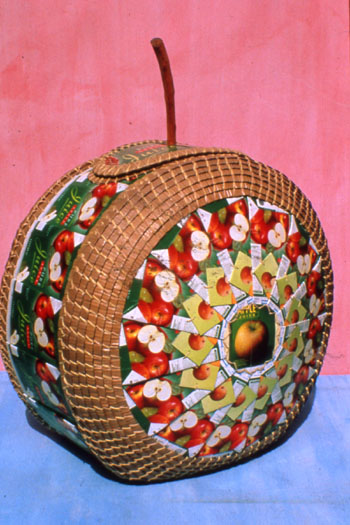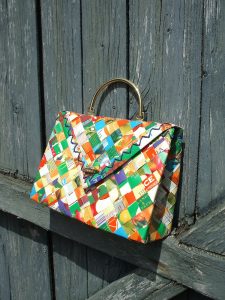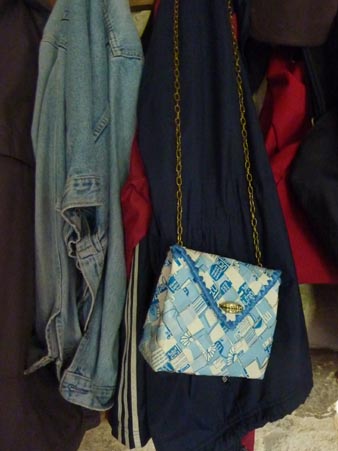Lois Walpole on weaving with Tetra Pak
It feels as though tetra pak weaving has always been part of my life but, in fact, I first used juice cartons to make baskets with in 1991. I had not seen them used by anyone else in the same way but, as the internet was still a dream for most of us at that time, it was of course always possible that someone somewhere else in the world had also spotted their potential. My use of them was, however, part of a logical progression in my work because I had started to look for materials that were already coloured so that I could move away from using dye and paint. The first baskets I made with tetra paks were assembled rather than woven, each whole carton being stitched to the next to create sheet material for bowls and laundry baskets.

Apple juice carton laundry basket 1995
In 1991, London, where I lived, was still a back-water as far as recycling went. A recently published article about my work suggested that I had raided my ‘recycling box’ for materials at that time; nothing could be further from the truth. We certainly did not have recycling boxes then and even after they were finally introduced it was still some time before tetra paks could be recycled. The layers of aluminium, paper, printing inks and plastic used to make the cartons were, and still are, a challenge for industrial recycling requiring considerable energy to separate the various elements. The cartons came into my house full of juice and left as baskets. If I had been able to put them into a ‘recycling box’ it is entirely possible that I would never have used them. I think it was the fact that they were being thrown away in almost mint condition that both upset me and inspired me to try and make things with them.

Handbag 1997
It wasn’t until 1995 that I discovered a way to cut the cartons that gave me long strips to to plait with. It seemed a perfect match of material and technique, the tetra pak being flexible, strong and relatively waterproof it also had, for me, the added bonus of colour. Since then many baskets and other objects made with milk and juice cartons have come and gone through my hands. Through classes and books I have also taught many other people how to do the same yet, I rarely hear what effect this has on other people lives. As a teacher one accepts that the knowledge passed on to others becomes theirs to do what they like with, without any expectation of further acknowledgement or credit. Nevertheless, it is always a delight to hear of the ways in which this knowledge has been passed into another pair of hands, and how it has been adapted, or added to, by them. (1)
Handbag
The brief to myself was; a bag to use in the summer, light in colour, to be worn across my body to free up my hands and arms, not too big, just for phone, camera and purse. Initially I was tempted to replicate the juice carton bag I made for Paul Smith in 1997 ( above). At his request it was a ‘Kelly Bag’ and though I like the design very much, I didn’t want a bag with a handle that I have to hold on to for my own use. The last time I went out with one like this I left it in a park! Since designing the Paul Smith version I have learnt that double wall tetra pak is a lot more robust, so double wall plaiting was the chosen technique. The edges are reinforced with bailer twine and I then added a magnetic catch and a brass plug chain (both left over from the Paul Smith sample making), as well as a crown cap for the ‘button’ on the front. It functions very well and does everything I ask of it, but after using it for a couple of weeks I am not absolutely sure that the colour of the stitching is right and I may change it, or make another bag!

Lois Walpole, Britain

PROFILE
Lois Walpole is of Anglo Scottish heritage and trained in Sculpture, Basket Making and Design.
She works full time as an artist/basket maker taking part in and curating national and international exhibitions, working to commission, designing for production, teaching and writing.
She divides her time between the Shetland Islands and the Charente, in south west France, where her studio is based.
Her blog gives the latest about her teaching and exhibitions and is where she talks about the baskets and basket related things that she finds interesting, inspiring, infuriating and intriguing…
Her self imposed rules are “no materials purchased and basket making techniques employed wherever possible”.
